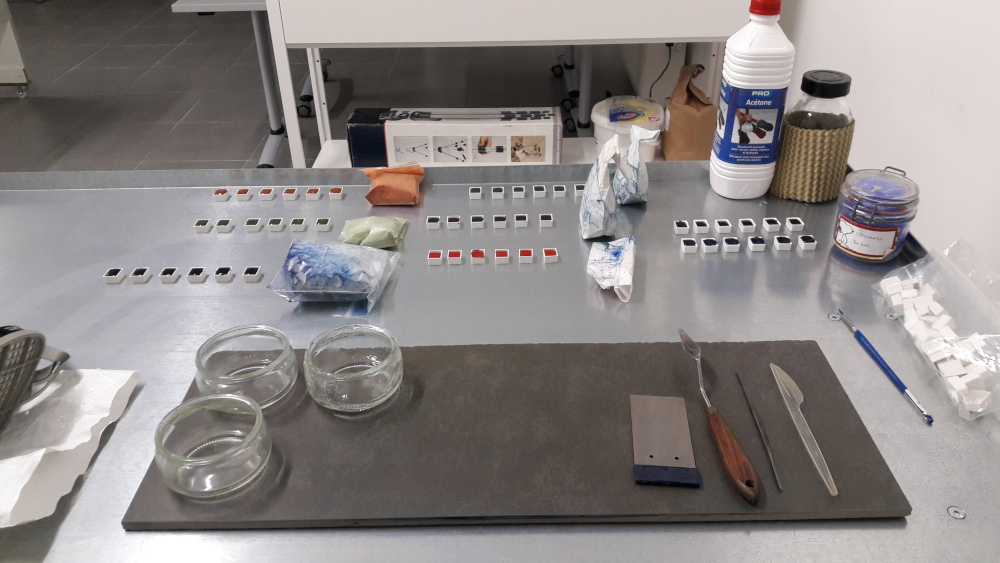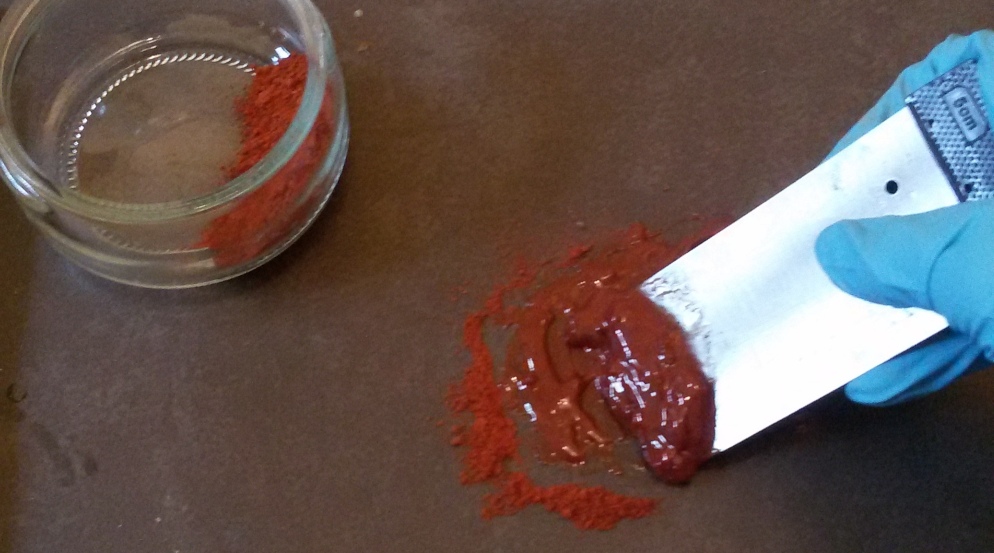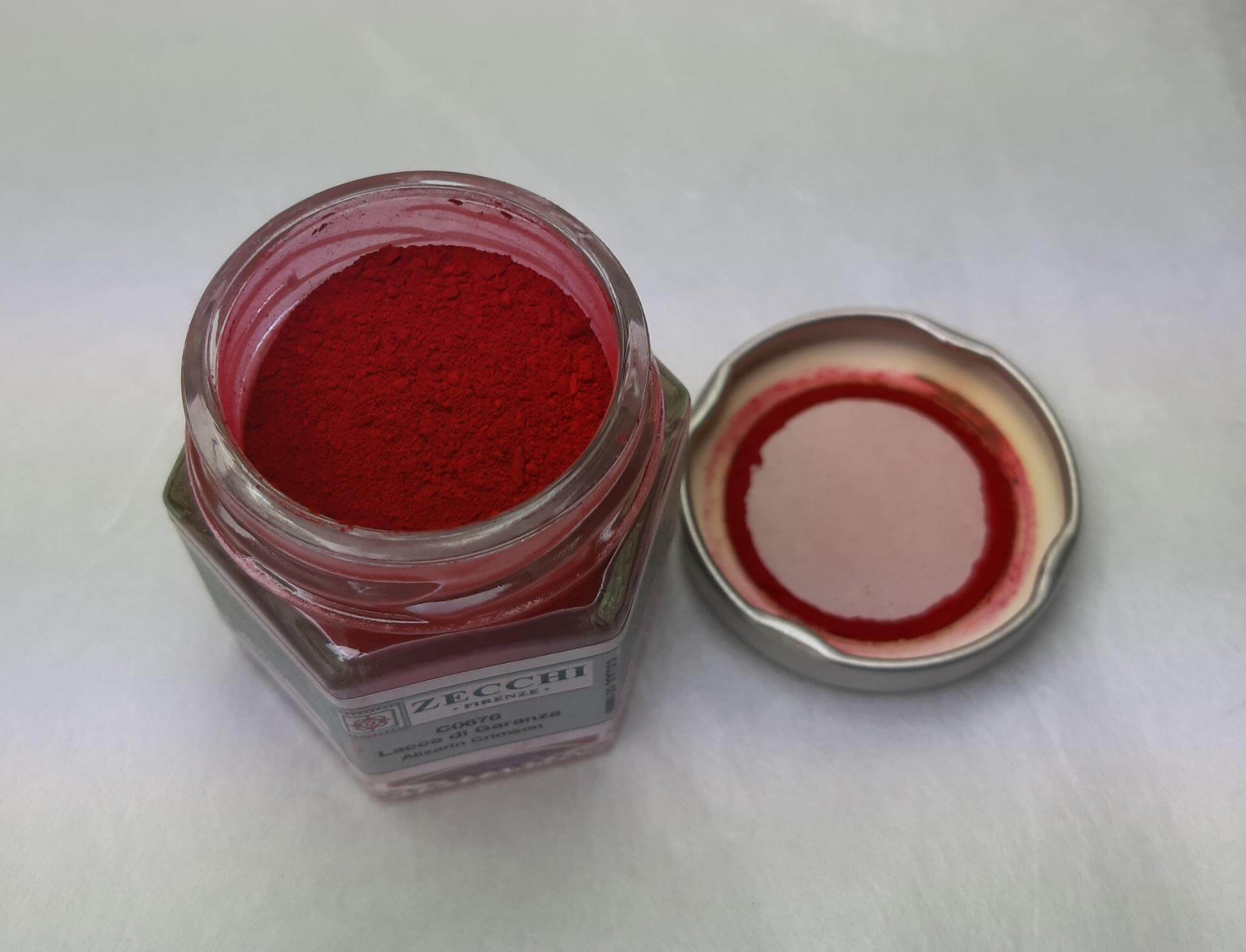Retouching colors DIY: Why and how to prepare them
As restorers, we often ask ourselves what is the true composition of the products that we use? Not all companies are as specific as we wish in matter of components, ingredients, and the purity of solvents that are used for solutions; even so, it has become a common attitude to prefer ready-to-use commercial products.
Retouching colors (aquarelles, gouaches and varnish colors such as Gamblin) are one of these products that are more often bought, rather than prepared by restorers themselves.
But why?
The process per se is not that complicated…
Yet, like everything, it takes time, skill and… more time!
Let’s take a look at what retouching colors are actually made of:
All retouching colors are made of a binder, to which a powder pigment is added.
The binder has to be a resin for making retouching colors such as Gamblin (Laropal A81 or Paraloid B-72, depending on the material you have to retouch), Gum Arabic or Aquazol for retouching color like aquarelles.
The pigment choice is also very important to guarantee that your color has good stability over time and a nice effect when applied on the surface.
All of the pigments that you choose to prepare are going to constitute your palette, which is an indispensable instrument in a restorers work: in your palette, you want both covering colors to retouch lacunaes and transparent colors to give the final touch to your retouch. You can create a standard palette, and then add variations to it for a specific artwork, if needed.
The binder choice:
During my studies in Florence I learned how to prepare both beautiful and high quality retouching colors, so I continued preparing my own colors afterwards. At that time, we used Balsam of Canada, an oleoresin with great refraction index and a low increase of polarity. But is this still the best option nowadays?
A fundamental research about this matter led by René de la Rie et al. (see Ref. below the article). In this article, the stability of a series of resins used in ready-to-use products has been researched (such as Paraloid B-72, PVAc, Buthyl Acrylates, mix of Buthyl Acrylates and ketone resin). This and other studies demonstrated that during ageing Laropal A81 based colors are not subjected to an increase in polarity. What does this actually mean? That in X years they are still going to be soluble in the same solvent.
How to prepare retouching colors with varnish as a binder:
Now let’s talk about the preparation. Here I will focus on the preparation of varnish colors using Laropal A81 as a binder (which is the same as the commercial GAMBLIN conservation colors). The preparation of these retouching colors presents some challenges: during the process the binder has to be soft like a paste, which allows it to nicely incorporate when the color is ready put it in a small container. The resin will then dry and become solid, but it will still remain soluble.
To make the colors, first you need to make a very high concentration solution of the resin. How do you do that? We know that the resin is soluble in a wide range of solvents: esters, ketones and Ethil Alcool (corresponding to LA3 in Wolbers solubility test), but it can also be solubilized in aliphatic hydrocarbons such as White Spirit D40, even though it forms unstable solutions. As the resin sets you have your high concentration solution.
Recipe
50 g of Laropal A81 in 100 ml of White Spirit D40. When the resin has settled, you can just take out the remaining solvent and take the quantity of Laropal A81 that you need to prepare each color. Meanwhile, the pigment needs to be ground into a very fine grain. You can then slowly add it to the resin while mixing with a spatula. Make sure to use your safety mask during all of these procedures and be careful that all of the powder is well enclosed in the resin. At this point your color is ready, now all you have to do is take your color with your spatula and roll it like honey (or spaghetti) and put it in your containers or directly in your palette.
Workshop in Brussels
I am organizing a workshop in Brussels on varnish color production. The course will be held in English or French. After a short theoretical introduction, participants will prepare colors and their palette. Every participant will leave with a brand new palette of homemade retouching colors. If you are interested in participating please contact me for further information on dates and prices.
https://www.artconservation.me/contact/
Check back for my following articles on the preparation of watercolors!
Ref.:
1. Materials and methods for the self-production of retouching colours. Laropal A81, Paraloid B72, Gum Arabic and Aquazol based colours, Roberto BESTETTI1*, Ilaria SACCANI11 CESMAR7- Centro per lo Studio dei Materiali per il Restauro cesmar7@cesmar7.org
2. De la Rie, E. R., Quillen Lomax, S., Palmer M., Deming Glinsman, L. & Maines C., 2000 An Investigation of the Photohemical Stability of urea-aldehyde resin retouching paints: removability tests and colour spectroscopy, in: Traditionand Innovation: Advances in Conservation. Contributions to the Melbourne Congress, 10-14 October 2000, London: Ashok Roy and Perry Smith, International Institute for Conservation of Historic and Artistic Works (IIC), pp. 51–59.
3. Leonard, M., Whitten, J., Gamblin, R., & De la Rie, E. R., Development of a New Material for Retouching, 2000, IIC Melbourne Congress, In: Tradition and Innovation: Advances in Conservation. Contributions to the Melbourne Congress, 10-14 October 2000, London: Ashok Roy and Perry Smith, International Institute for Conservation of Historic and Artistic Works (IIC), pp. 111-113. In this research colours based on Paraloid B-72, PVAc (Golden), Buthyl Acrylates (Magna), mix of Buthyl Acrylates and ketone resin (Charbonnel Restoration Colours), Mastic (Maimeri) and Laropal A81 have been compared, with a long artificial ageing (6000 hours) based on Xenon lamp (spectrum similar to indoor sunlight). The color selected for each bran were Titanium white, Ultramarine blue Cadmium Yellow Medium, Ivory Black, Yellow Ochre, Viridian, Alizarin Crimson.
4. De la Rie, E.R.& McGlinchey, C.W., 1990, New synthetic resins for picture varnishes, in Cleaning, retouching and coatings, London: Mills & Smith, pp.168-173.



